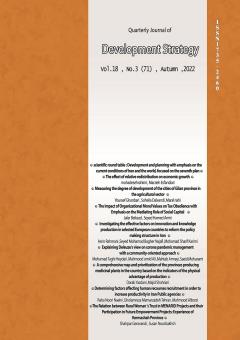A comprehensive map and prioritization of the provinces producing medicinal plants in the country based on the indicators of the physical advantage of production
Subject Areas :darab yazdani 1 , majid shahriari 2 *
1 - Medicinal Plants Research Center, Jihad University Medicinal Plants Research Institute, Karaj, Iran
2 -
Keywords: Keywords: medicinal plants, physical advantage, comprehensive map, ranking, Iran.,
Abstract :
Determining the relative advantage of agricultural products in different regions is one of the important dimensions of agricultural policy and planning, based on which the appropriate pattern of production and cultivation can be achieved in different regions according to the conditions in each region. The current research aims to prioritize the provinces that produce medicinal plants in the country based on the indicators of the physical advantage of production (advantage of scale, efficiency advantage and collective advantage) and their fluctuation coefficient during the period of 2011-2018 using the numerical taxonomy method. The results showed that during a period of 18 years, South Khorasan, Jiroft and Razavi Khorasan provinces had the highest average scale advantage index (SAI) and the highest average efficiency advantage (EAI) was also in Alborz, West Azarbaijan and Lorestan provinces with 13/67 respectively. , 6/47 and 6/19 were obtained. According to the results of collective advantage (AAI), the provinces of Hamadan, Semnan and Sistan and Baluchistan have the lowest fluctuation coefficient of collective index with 0.26, 0.28 and 0.33 and the provinces of Alborz, Jiroft and Sistan and Baluchistan with 31.40 respectively. 2.3 and 1.65 had the highest average collective advantage among all the provinces of the country. Finally, in order to summarize, using GIS software, a comprehensivemap of the country for medicinal plants was drawn based on the indicators of physical advantage.
- احمدوند، محمد، رحیم؛ و نجف پور، ذبیح اله.(1385). ارزیابی و تحلیل وضعیت شاخصهای فیزیکی مزیت نسبی دانههای روغنی در ایران در سال 1382. پژوهشها و سیاستهای اقتصادی. 14 (37 و 38):5-15.
- -¬ کهنسال, محمدرضا, دهقانی دشتابی, مریم, رشیدی رنجبر, فهیمه, اسفندیاری, ساسان. (1398). بررسی وضعیت صادراتی گیاهان دارویی با رویکرد مزیت نسبی، ساختار بازار جهانی و نقشهریزی تجاری ایران.13(1)،160-133.
- -¬ اسکوهی، مائده و اسماعیلی، کاظم. (1400). تحلیلی بر نظریههای حکمرانی و مدیریت منابع آب در ایران. فصلنامه آب و توسعه پایدار، 8(1)، 1-10.
- آهنگری، صدیقه، مجاوریان، سید مجتبی و حسینی یکانی، سید علی. (1396). اولویتبندی عوامل مؤثر بر موفقیت یک کالا در رینگ کشاورزی بهابازار کالای ایران. اقتصاد و توسعه کشاورزی.1 (39) ،35-27.
- پیراسته، حسین و کریمی، فرزاد. (1385). بررسی مزیتهای نسبی محصولات زراعی در استان اصفهان. اقتصاد کشاورزی و توسعه.1(14). 68-39.
- چیذری، امیرحسین، شرزه¬ای، غلامعلی، کرامت زاده،علی. (1384). تعیین ارزش اقتصادی آب با رهیافت برنامهریزی آرمانی (مطالعه موردی: سد بارزو شیروان). مجله تحقیقات اقتصادی. 4 (44)، 66-39.
- عابدی، سمانه. (1395). بررسی مزیت نسبی تولید محصولات کشاورزی مبتنی بر زیستفناوری (مطالعه موردی: گندم و ذرت در استان فارس). تحقیقات اقتصاد و توسعه کشاورزی ایران. 47(3), 569-579.
- قاسمی، مریم، نیک نامی، مهرداد و رفیعی، حامد. (1398). عوامل مؤثر بر دانش و نگرش کشاورزان نسبت به مزیت نسبی محصولات زراعی در شهرستان گرمسار. تحقیقات اقتصاد و توسعه کشاورزی ایران.4 (50)، 690-677.
- کشفی،بناب.(1389). مزیت نسبی اقتصادی کشت و تجارت گیاهان دارویی در ایران و ارزش آن در بازارهای جهانی.بررسیهای بازرگانی.8(44)،87-67.
- محمدرضایی، رسول،شهبازی، حبیب،کاووسی کلاشمی، محمد و خداوردی زاده، محمد.(1390). ارزیابی پایداری شاخصهای مزیت نسبی صادرات و تولید خرمای ایران، مجله دانش کشاورزی.(2) 19: 176-165.
- محمدی، حمید، کیخا، احمدعلی، دهباشی، وحید و اردوان، خالویی. (1391). بررسی مزیت نسبی تولید چغندرقند در ایران. فصلنامه چغندرقند.1(28).93-81.
- محمدی، یاسر، شلالوند، مرتضی و رضاپور, کوروش. (1397). تعیین الگوی کشت بهینه محصولات زراعی در واحدهای تولیدی با تحلیل مزیت نسبی منطقهای و ملی. تحقیقات اقتصاد و توسعه کشاورزی ایران.4 (49) ،734-719.
- محمودی، ابوالفضل، یاوری، غلامرضا و کلوندی، رقیه. (1399). بررسی جایگاه ایران در بازار جهانی طالبی و خربزه و غربالگری شرکای تجاری. تحقیقات اقتصاد و توسعه کشاورزی ایران.2 (51)، 312-295.
- میرباقری، سید شهاب، رفیعی، حامد و اکبرپور، حامد. (1398). اولویتبندی مناطق تولیدی گندم آبی و دیم در ایران بر مبنای شاخصهای مزیت تولیدی. اقتصاد کشاورزی و توسعه.1(27)، 118-91.
- نصرآبادی، اسماعیل .(1394). شواهد زیست محیطی بحران آب ایران و برخی راهحلها. فصلنامه راهبرد اجتماعی فرهنگی،4(15): 65-89.
- Akhtar, N., Zakir, N. and Ghani, E.2008. Changing revealed comparative advantage: a case study of footwear industry of Pakistan. Journal Of The Pakistan Development Review. 695-709.
- Arora,G., Feng, H. Anderson, C.J. and Hennessy, D.A.2020. Evidence of climate change impacts on crop comparative advantage and land use.Journal Of AgriculturalEconomics.51(2):221-36.
- Bayzidnejad, D., Khodaverdizadeh, M. and HashemiBonab, S.2021. Comparative Advantage of Production and Measuring the Competitiveness of Major Crops of Urmia County by the Policy Analysis Matrix (PAM). International Journal of Agricultural Management and Development. 11(1):35-47.
- Brewer, P.2001. International market selection. developing a model from Australian case studies. International Business Review.10(2):155-74.
- Lee, J. 1995. Comparative advantage in manufacturing as American determination of industrialization: The Korean case. World Development. 23: 1195-1214.
- Quddus, M. A., and Usman, M.2011. Comparative advantage of major crops production in Punjab: an application of policy analysis matrix. The Lahore Journal of Economics. 16(1):93-94
- Sarookhani, B., Tavakoli Vala,Zh. and Rostamzadeh, A.2012. Numerical taxonomy and its application in social research. Historical sociology. 4(1): 171-194.
- Vander Eng, P.2004. Productivity and comparative advantage in rice agriculture in South-East Asia since 1870. Asian Economic Journal. 18(4): 345- 370.
- Wu, Q., and Yang, J. 2021. Comparative advantage analysis of production of jasmine tea in China. Journal of Physics. IOP Publishing.
- Yagoub Elryah, D.2015. Back to the Agriculture-the Development of the Comparative Advantage of Sudan’s Commodities. Journal of Finance and Economics. 3(1):1-5.

